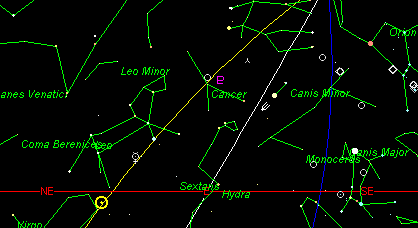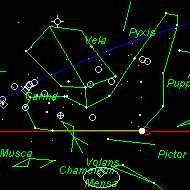

Professor Maspero held that Pyramid Texts referred to the rising of Sirius and not its heliacal rising. In 4420 BC, Sirius, the brightest star in the heavens, rose cosmically with Regulus, the brightest star on the ecliptic, precisely one lunar month before the summer solstice. Two decans (an ancient Egyptian measurement equating to 20 days) before the summer solstice, Sirius and Regulus emerged from the Sunís rays to rise heliacally at dawn, being an important sign warning of the Inundation of the Nile. THE IMPORTANCE OF REGULUS Regulus (Alpha Leonis) in the constellation of the lion, is the brightest star on the ecliptic and is thus the obvious choice for measuring the true length of the sidereal year. With the realisation of this fact and the nature of itís rising in the era of 4420 BC, it is very easy to understand how the ancient Egyptians knew the true length of the sidereal year.
In the era of 4420 BC, Canopus, the second brightest star in the heavens, appeared for the first time from the Giza perspective, over the southern horizon, due south. Canopus is in the constellation of Argo, the boat, explaining the landing of the ark. ALPHA ORION (BETELGEUSE) aligned with the south shaft of the Kingís Chamber in 4420 BC and also marked the Vernal Point. IOTA DRACONIS was the closest star to the North Celestial Pole in 4420 BC and aligned with the entrance passageway of the Great Pyramid. These findings are the original work of Alison Moroney and were first published in her book Pathway to Atlantis (1998). Astronomical drawings generated by Skychart III.
Copyright © Alison Moroney, 1994 |
 THE RISING OF CANOPUS
THE RISING OF CANOPUS